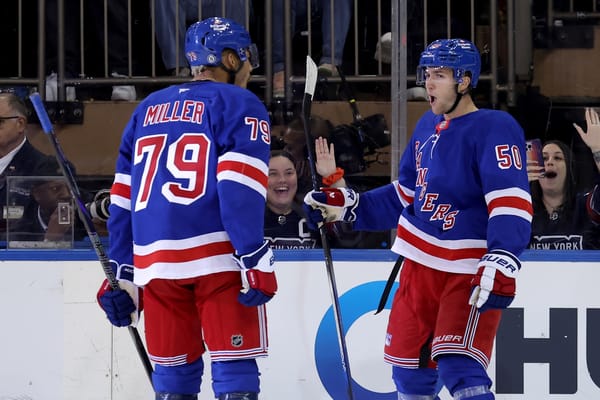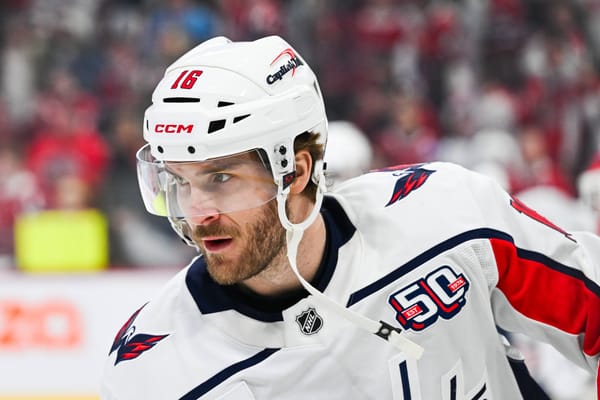Finding Oscar Lindberg’s Replacement at Center
On two different occasions, I warned that losing Oscar Lindberg was the worst (realistic) outcome of the 2017 expansion draft. So of course, the Rangers did lose Lindberg to Vegas. Rangers fans should be upset, but should not blame management. The gap between him and other options was not high enough to justify whatever trade it would have required to keep him. In terms of options within the team’s control, losing him for nothing seems to have been the least bad option. So it goes.
Life continues. As I advised, replacing him will not be easy. Good centers are in-demand for a reason; they don’t exactly grow on trees. The Rangers will have to fill the hole in some way, though.
Let’s first cross off some potentially popular ideas that probably aren’t realistic options. Free agents Brian Boyle, Nick Bonino, and Mike Fisher are almost certainly all too expensive. Bonino and Fisher can do better than fourth-line minutes, anyway. The same would seem to be true of Sam Gagner, who had a 50-point season during a comeback year (though if not, then jackpot). Boyle would be a luxury the Rangers can’t afford without a massive nostalgic discount on his end. However, they do still have options.
Internally, the Rangers have one serious candidate in Boo Nieves. Eight months ago, he would have been the odds-on favorite for this spot. However, despite his NHL debut, 2016-2017 was a tough season for him (and practically all of Hartford). Multiple injuries sidelined him for roughly half of the season. Even when he was healthy enough to play, he never looked quite right. Lack of talent around him didn’t help. He ended up with just six goals and 18 assists in 40 games; not exactly inspiring from a 23-year-old.
However, the ability is still there. He’s a great skater, holds his own on faceoffs, and reads the game well defensively. He was fantastic for Hartford during his short stint the year before and nearly made the Rangers out of training camp last October. The Rangers can’t slot him into the position and consider it dealt with, but he’ll be a major preseason competitor for a roster spot.
There are a few interesting free agent options. Caps’ forward Daniel Winnik is maybe the most distinguished one. He’s averaged around eight goals and 18 assists over the last five seasons, which certainly would replace Lindberg’s offense, and he’s a tremendous shot suppresser. The downside on him is that he hasn’t played center in two years, and he’s subpar on faceoffs. While wing would seem to be his best position, he’s still shown an ability to be a very good depth center. A model from Hockey Graph’s Matt Cane projects that Winnik will sign somewhere for around $1.8M annually. That’s right on the border of tolerable spending for the Rangers.
David Desharnais would be an unorthodox fourth-line center, but so was Brandon Pirri. While recency bias might cloud it, Pirri centering the fourth line worked out pretty well for much of the 16-17 season. Desharnais had an off-year, but that could be to the Rangers’ benefit. If he can regain his form that he showed the previous six seasons, then Desharnais could be a steal. Even if not, he still projects to provide capable bottom-six minutes. Though he may not fit the archetype the Rangers need, they’re better off signing a good, redundant center than a bad one who does (think 15-16 Jarret Stoll).
Carolina’s Derek Ryan could be a diamond in the rough. Ryan is a short, undrafted 30-year-old coming off his rookie year. That is not a typo. Add in the fact that he played depth minutes for a non-playoff team in a remote market, and Ryan is the definition of “under the radar.”
Ryan had 11 goals and 18 assists in 67 games last season. Even if that was a fluke, his shot suppression numbers were tremendous; opposing teams had a tough time generating offensively against him. He was also strong on defensive zone faceoffs, making him a great PK1 unit option. Predicting a salary for Ryan is tough simply because he’s a total outlier. I’d bet job security means more to him than anything else. A multi-year contract at $1.5M or under doesn’t seem unrealistic.
Finally, trades are always possible. Though there would be numerous ways to accomplish this, Occam’s Razor suggests that Antti Raanta would be involved. Two teams who could use Raanta and have a fitting center to spare are the Winnipeg Jets and Buffalo Sabres.
Winnipeg’s Andrew Copp is just 22 and has already demonstrated bottom-six value. He plays with an edge and scores his fair share of goals. The Rangers would be able to sign him for under $1 million this summer, and would have him at a cost-controlled price for multiple years after. Since he was Nieves’ teammate at the University of Michigan, the Rangers’ scouting staff are very familiar with Copp.
Buffalo has a massive surplus at center to the point that top prospect Sam Reinhart was moved to wing last season. Now, two young depth centers in Johan Larsson (25 in July) and Zemgus Girgensons (turned 23 in January) are up for new contracts. Though not as frugal as Copp, both will still be somewhere around $1M-1.2M. Just as Lindberg would have been. Again, both fit the mold of what the Rangers need in terms of an economical shot-suppressing center who can chip in some offense.
No question, there are some quality, realistic options for the Rangers. However, there are not even close to enough that they can take filling the spot for granted. Some teams are going to overpay for name-brand depth centers. Some teams are going to sell themselves on a gritty veteran who can win faceoffs and do nothing else, anchoring their fourth lines the process. The Rangers have to make sure they’re one of the teams who comes away with a competent, cost-effective center from the small handful that are obtainable.




